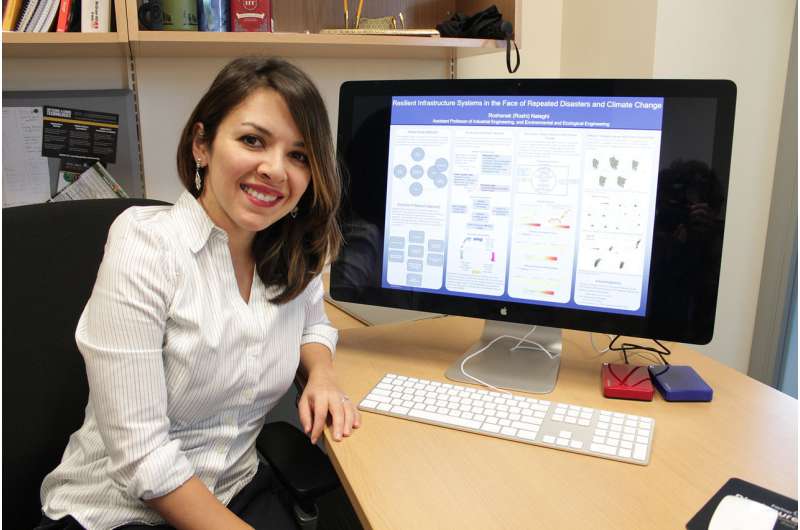Study's projections show climate change to increase commercial Indiana energy consumption, reduce residential use

New projections show climate change could induce a 5 percent increase for the average commercial building's energy consumption in Indiana by the year 2100, while reducing an average residential home's energy use by 3.5 percent.
"These are looking at 'statistically representative' average residential homes and commercial buildings in Indiana, so the effects of climate change on residential and commercial energy consumption will range above and below these estimated projections," said Roshanak Nateghi, an assistant professor in Purdue University's School of Industrial Engineering and Environmental and Ecological Engineering.
Since the largest part of residential energy demand in Indiana is attributed to heating, future warming scenarios could lead to reduced end-use residential demand due to lower space heating and water heating needs. In the commercial sector, the overall energy demand is expected to increase under future warming scenarios. This is because the increased space cooling required during hot summer months will likely outpace the reduced heating needs during the more temperate winter months.
"One surprise for us was that the demand goes down for statistically representative average households in the residential sector," Nateghi said. "The main reason is that air conditioning use is only 2 percent of energy consumption for residential households. In fact, the majority of residential energy use is for heating, at about 74 percent."
The majority of existing energy-economy models do not account for climate variability and change.
"So, we propose a multi-paradigm framework to help extend the energy-economy models, such as a well-known model called MARKAL, to be able to account for climate change," said Sayanti Mukherjee, a postdoctoral research associate in the Division of Construction Engineering and Management and a visiting scholar in the School of Industrial Engineering. "To illustrate the applicability of our proposed framework, we used the state of Indiana as a case study."
She and Nateghi co-authored a paper about the research published online Nov. 20 in the journal PloS One. They refer to their approach as a "multi-paradigm" framework because it integrates different types of modeling techniques.
The study compared the future projections to historical energy consumption for cooling, heating and water heating for the commercial and residential sectors from 1981–2013.
Two sets of projections were calculated: one assumes a future world with lower greenhouse gas emissions than the other because more aggressive steps are taken to mitigate emissions. The analysis concluded that under both scenarios, by the year 2100 the effects of climate change alone will cause energy consumption for an average commercial building in Indiana to increase by 5.1 percent and 5.4 percent, respectively. Energy consumption for the average residential household is projected to decrease by 3.5 percent on average under both scenarios because warmer temperatures will reduce energy use for heating.
"Projecting long-term trends in energy demand is an increasingly complex endeavor due to the uncertain emerging changes in climate, policy, the regulatory environment, the economy and technology, among other factors," Mukherjee said.
The projected changes are in addition to the expected changes in energy consumption caused by a variety of factors such as changes in electricity rates, population and energy policy.

The work was conducted as part of the Indiana Climate Change Impacts Assessment (IN CCIA) project, led by the Purdue Climate Change Research Center in the university's Discovery Park. The IN CCIA is a multidisciplinary effort to provide accessible, credible climate science to Indiana residents, allowing a better understanding of climate change‐related risks that will support more effective planning. Another team working on the assessment provided critical climate-change data, "downscaling" general climate models to focus on Indiana. The findings will be part of the Indiana Climate Change Impacts Assessment being coordinated by the center to be released next year.
Being an importer of electricity from the neighboring states and Canada, Indiana is vulnerable to supply shortages in cases of shifts in end-use demand due to reasons such as climate variability and change. The state ranks second in terms of coal consumption in the energy sector.
"Changing patterns of energy consumption, therefore, will have significant implications for the environment," Nateghi said.
The researchers used a Bayesian, "ensemble decision-tree" based algorithm to develop predictive models.
For the residential sector, the findings reveal that the future median energy demand under the lower-emissions scenario is projected to be 278.5 trillion British thermal units (Btu), a 3.5 percent decrease from the historical median, and can range from 243.7–323.2 trillion Btu. Under the higher-emissions scenario, the median residential demand is projected to be 278.7 trillion Btu, also a 3.5 percent decrease from the historical median, and could range between 243.0–276.9 trillion Btu.
The demand in the commercial sector will be on-average substantially higher than the historical average values under both emission scenarios. More specifically, under the low-emission scenario, the average demand will be around 179.9 trillion Btu, a 5.1 percent increase than the historical median, and it could range between 147.8–214.1 trillion Btu. Similarly, under the high-emissions scenario, the projected median commercial demand will be around 180.5 trillion Btu, a 5.4 percent increase from the historical median and could range between 146.4–211.4 trillion Btu under the uncertain future scenario.
The projected increase is due to the commercial sector's greater use of cooling energy, relative to the residential sector, and higher projected daytime temperatures.
"It should be noted that while our proposed framework accounts for demand variation due to climate change, it does not account for potentially higher intensity and frequency of climatic extremes such as ice storms and tornadoes under climate change," Nateghi said. "Future work is needed to extend our paradigm to also account for such weather and climate extremes that could become much more intense and frequent under climate change, and have significant impacts on our energy sector in the future."
The projections could be underestimating the potential influence of climate change because they are based only on the expected rise in temperature, not relative humidity.
In future work, the researchers will use a more sophisticated "dynamically downscaled" model from the Climate Change Research Center to more accurately predict the impacts of climate change on energy consumption.
The researchers also are expanding their work to prepare projections across other energy-intensive states in the United States.
More information: Roshanak Nateghi et al. A multi-paradigm framework to assess the impacts of climate change on end-use energy demand, PLOS ONE (2017). DOI: 10.1371/journal.pone.0188033
Journal information: PLoS ONE , Ecological Engineering
Provided by Purdue University


















